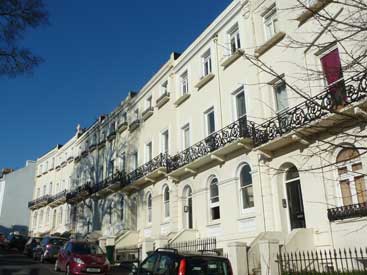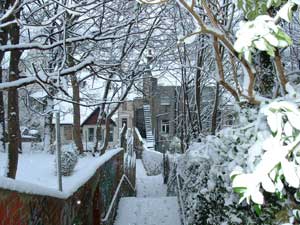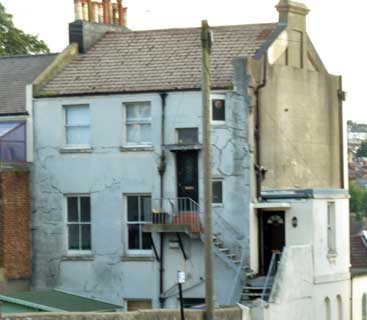Round Hill Crescent
See also the Round Hill Crescent section on pages 50-57 of the proposed update for Round Hill's conservation character statement:
Practise using the Census data site e.g. study of Roundhill Crescent in 1871
- At http://www.freecen.org.uk complete these fields ONLY:
- Surname: Izard
- First name: John
- Census County: Sussex
- Census Place: Brighton
- Census Year: 1871
- Click the SEARCH button
- Select for all the information
- Continue viewing data for more households in the same street (or one nearby) by clicking the or buttons
You will gather data on everybody living in Roundhill Crescent in 1871, including servants.
A known resident is John IZARD of 31 Round Hill Cres (born in Sussex). He was a collector for a water company, but also played a part in selling plots on The Round Hill Park Estate for the Conservative Land Society.
Another is Georgiana F GURMARVENS of 6 Round Hill Cres (born in Kent).
The lets you fill in the street name. Take care to shorten "Roundhill Crescent or Round Hill Crescent" to "Round Hill Cres" (as above). The birth county is optional.
When the houses were built
c1865 1-13 Round Hill Crescent Grade II listed
c1865 19-21 Round Hill Crescent Grade II listed
c1865 23-27 Round Hill Crescent Grade II listed
c1865 69 & 71 Round Hill Crescent Grade II listed
c1865 101-113 Round Hill Crescent Grade II listed
1871 94 & 96 Round Hill Crescent.
1877 80-92 Round Hill Crescent.
1878 18-28 Round Hill Crescent.
1879 68-86 Round Hill Crescent.
1880 73 & 75 and 81-91 Round Hill Crescent.
1883 58 Round Hill Crescent.
1883 73 - 77 Round Hill Crescent.
1885 38, 40, 42 & 44 Round Hill Crescent.
1895 39 - 57 Round Hill Crescent.
1897 36 Round Hill Crescent.
1897 17 Round Hill Crescent.
1901 30 Round Hill Crescent.
The Wikipedia entry for Roundhill Crescent usefully identifies five groups of houses built in the mid 1860s. under the heading ARCHITECTURE.
These are also identified by Historic England which offers further descriptions in its listings, marking locations on its maps using very small blue triangles.-----Nos.1-13-----Nos.19 & 21-----Nos.23-37-----Nos.69 & 71-----Nos.101-113-----The latter are the current house numbers.
The street was re-numbered in 1881 when there were homes on both sides and it was possible to use ODDS on the north side and EVENS on the south side.
An 1881 street directory first page-|-continuation page shows the old numbering. An 1882 street directory whole street listed on one page shows the new house numbers. EXAMPLE: 44, 45, 46, 47, 48, 49 on the north side (just east of the junction with D'Aubigny Road) become 101, 103, 105, 107, 109, 111 and 113 (an extra one). There has been further renumbering (employing alphabetical letter) after homes have been divided into flats.
West end of RHC (North side)
1 to 11
See Historic England's listing (designated 2 March 1981) of properties later numbered as ODDS with alphabetical letters for different flats.
Annuitant* (7), Candle Maker (retired), Captain M S (Retired), Clerk, Domestic servant (10), General Servant (2), Governess, Income arising from Dividends, Inland Revenue Office, Nonconformist Minister, Physician (Retired), Retired Builder, Retired Schoolmaster, Scholar (11) Servant (Domestic) (2), Student (2), Student of The Inner Temple
* Possibly somebody on an annual allowance or receiving an annual income frrom investment. Also used for institutionalized pensioners.
An 1859 street directory shows Roundhill Crescent with just 6 occupied households on the north side at each end: numbers 4, 5, 8, 9, 12 (west end) 45 and 49 (east end). It shows No 5 as being owned by Mr J. Coppinger whose son Walter Arthur Copinger (1847-1910) was a barrister remembered for writing the standard legal reference work on Copyright: Copinger and Skone James on Copyright.
To the east of Lennox Road (The Cats Creep)
See Historic England's listing (designated 2 March 1981) of properties now numbered as ODDS (19, 21).
No mention here of occupations.
Note that during the 1860s, the alley (now the Cats `creep) was a road, so the gabled terracotta walled house appears later. A gap remains in its place for some time. Although it was already clear that the steep Lennox Road was not viable for carriages, planning permission for the steps to what became Lennox Passage was granted in 1900.
Moving further eastwards (past the telephone box), see Historic England's listing (designated 2 March 1981) of properties now numbered as ODDS (23-37). They can be identified by the papapets on the roofs. Although they go unmentioned in the 1871 census, they were built in the mid 1860s as the listing mentions.
A few houses to west of Ashdown Road
30 and 31
See Historic England's listing (designated 2 March 1981) of properties now numbered as ODDS 69 and 71.
Collector To Water Company, Domestic Servant, Railway Clerk,
Scholar (3), Domestic Servant.
The head resident at No 31 is also Agent to the Conservative Land Society doing work for the Round Hill Estate Office which was selling parcels of land from the Round Hill Park Estate to people looking for properties in Round Hill to live in or as investments.
You will also find his name in the 1871 street directory.
The Post Office Directory of Sussex 1878 shows 17 households in Round Hill Crescent. Check out No 31 to see that John Izard (head) works for the Round Hill Estate Office.
A Brighton street directory 1878 clarifies that his wife, Susanna, offers private tuition.
ASHDOWN ROAD (the entrance to which is a few houses further to the east beyond current No. 79) was not a residential street until the 1880s.
From D'Aubigny Rd to Upper Lewes Rd
44-50
See Historic England's listing (designated 2 March 1981) of properties now numbered as ODDS (101, 103, 105, 107, 109, 111, 113)
Jobs: Annuitants (4), Captain (6th Dragoons / Inniskillings), Cook, Domestic servant (5), Governess (2), Housemaid, Interest On Money (2), Ladies’ School, Nurse (2), Scholar (8), Teacher
Note that teaching is an occupation which is opening up for women, especially in Brighton (which became to be known as "school city") and in the more affluent streets. The 1882 street directory shows 109 Roundhill Crescent (formerly No 48 before the street was re-numbered in 1881) as a boarding and day school rn by Mrs Stephenson and Miss Walker.
Female employment
The article (below) indicates that in 1871 it wasn't fashionable for women to work. Roundhill Crescent was also a fairly wealthy street with many residents receiving income from invesments.
Read the excellent article The Missing Half: Female employment in Victorian England and Wales [PDF] by Dr Xuesheng You
Towards the end of the 19th century and the turn to the 20th century, occupations open up for women, though many are home-based e.g. laundress and dressmaker and relate to the poorer streets to the north of Round Hill further out from the town centre. There were doubtless many women working as dressmakers in the absence of all the large department stores which came later. Some local history sites mention that the title of "dressmaker" was occasionally used as a cover by women offering services which one would not want to declare in a population census, but this footnote should not be used to discredit an occupation which was widespread before so much of our clothing was factory made.
Women like the doctors Mabel Jones and Louisa Martindale and Helen Boyle were breaking new ground as women doctors, opening up new opportunities by example. As noted in relation to 109 Roundhill Crescent in 1882 (formerly No 48) teaching was also opening up as an occupation for women.
Practise using the Census data site e.g. study of Roundhill Crescent
- At http://www.freecen.org.uk complete these fields ONLY:
- Surname: Pritchett
- First name: Louisa
- Census County: Sussex
- Census Place: Brighton
- Census Year: 1891
- Click the SEARCH button
- Select for all the information
- Continue viewing data for more households in the same street (or one nearby) by clicking the or buttons
You will gather data on everybody living in Roundhill Crescent in 1891, including servants.
A known resident is Louisa PRITCHETT of 1 Roundhill Cres (born in Gloucestershire)
Another is Charles John CROSSLEY of 21 Roundhill Cres (born in Sussex).
Another is Joseph ALLFREY of 22 Roundhill Cres (born in Sussex)
The lets you fill in the street name. Take care to shorten "Roundhill Crescent" to "Roundhill Cres" (as above). The birth county is optional.
North Side (1891 census)
1 to 113
15 17 39 41 43 47 49 51 are empty plots
South Side (1891 census)
2 to 96
32 34 36 46 48 50 52 54 56 are empty plots
Front façade of 101-113 Roundhill Crescent

There are musicians at both ends of the terrace: 101 and 111
Street Directories for Roundhill Crescent
The 1891 Street Directory Nos 1 to 40---Nos 42 to 109 complies with the census records in relation to missing numbers, though odd numbering only goes up to 109 while the census record shows a family at 111 who come from London.
The head, William Gordan GLANVILLE (aged 75) lives on private means. His wife Louisa Maria (also aged 75) was born in Lambeth, while their two daughters Fanny Louisa (aged 41) and Laura Gordon (aged 39) are born in St Johns Wood and Norwood respectively. Both remain single. Fanny is listed as a Visiting Governess and Laura as a Professor of Music.
The 1896 Pikes Street Directory shows that little has changed in relation to the absent houses. No changes on the south side, which has as many as 9 plots unbuilt on. On the north side, only numbers 39 and 41 are now built and occupied. Interestingly, "Here is LENNOX ROAD" appears between properties 13 and 19: still no room for Nos 15 and 17.
However, the 1910 Pikes Street Directory
Nos 1 to 17 north--- Nos 19 to 123 north and 2 to 96a south
shows both numbers 15 and 17 as built and occupied. This directory also shows The Lewes Road Hospital for Women and Children, present at 101 Round Hill Crescent since 1905, but just about to move to Ditchling Road.
These plots could not be built on while Lennox Road, created in the 1860s, was in the way. However, planning permission sought in 1898 was granted in 1900 for conversion of Lennox Road into a passageway with steps since known as The Cats Creep. This made way for new houses on both Roundhill Crescent and Richmond Road.

Occupations in Roundhill Crescent
General comments and comparisons
In addition to the following list, there are 39 people living from "Private means or income". These are frequently the heads of households. Many are of pensionable age. Few are recorded in the census as "pensioners", though the adjective "retired + occupation" is recorded in a number of cases. There is even a retired common traveller.
There are 23 "Domestic" or "General" Servants.
Note within the list that there are very few laundresses [as exist further up Round Hill where drying conditions are probably better and people are generally less well off]. A mere two households in Roundhill Crescent:
58 Roundhill Crescent offers two laundresses and one laundress's assistant. At No. 76, there is one laundress and one ironer. That's all. The population is generally older i.e. many of retirement age with adult sons and daughters living in the same households.
Roundhill Crescent contributes to the description of Brighton as "School Town". Below the comprehensive list is a section on this.
List of Jobs: numbers 1 to 111 Roundhill Crescent
Cheesemonger, Dentist, Boot and shoe maker, Dressmaker, Engine Cleaner, Cabman, Dressmaker (aged 12), Surgeon, Journalist Newspaper Manager, Heraldic Engraver, Pianoforte Teacher, Signal Porter Railway, Retired Coachman, Congregational Minister, School Mistress, Booksellers Assistant, School Mistress, School Mistress, Coal Merchants Clerk, Retired Military Officer, Water Rate Clerk, Dressmaker, Mantle Shaw Apprentice, Dressmaker, Drapers Assistant, Dental Pupil, Telegraphist, Dressmaker, Grocers Assistant, Drapers Assistant, Laundress, Ironer, Furniture Salesman, Clerk China Glass, Manager of Fish Shop, Mantle Maker, General Carriers Clerk, Post Office Sorting Clerk, Teacher, Fitter Engine Apprentice, Sign Writer / Painter, Home Assistant, Sign Writer / Painter, Carpenter, Boarding House Keeper, Upholsterer, Board School Teacher, Board School Teacher, Lithographic Artist, Tailoress Apprentice, Insurance Agent, Bank Clerk, Retired Wine Merchant, Drapers Assistant, Contractor, Milliner, Dressmaker, Milliner, Ladies Outfitting, Milliner, Milliner, Government Contractors Agent, Army Scripture Reader, Assistant School Mistress, Clerk, News Proprietor, Assistant Town Hall Staff, Money Taker North Road Baths, Governess, Retired Common Traveller, Post Office Telegraphist, Inspector of Groynes, Teacher of Music, Captain, Retired Broker, Lieutenant Corporal 4th Dragoons, Soldier 6th Dragoons, Coal Merchant, Coal Merchant, Coal Merchant, Monumental Mason, Housekeeper, Pharmaceutical Student, Joiner, Visiting Governess, Professor of Music, Housekeeper, Agent Singer’s Sewing Machine.
Schools and Teachers in Roundhill Crescent
The 1891 Street Directory Nos 1 to 40---Nos 42 to 109 shows an Assistant H.M. Inspector of Schools (no 11), two Elementary School Mistresses and a Teacher of Swedish drill (no 23), a young ladies school run by Miss Reed (no 27), a Certified School Mistress (no 34), an Assistant School Mistress and a Pupil Teacher (No 37), a Preparatory Day School run by Miss Edwards (no 44), Board School Teacher*** (no 59), Pianoforte Teacher (No 66), 3 Schoolmistresses (69) , Teacher (No 81), School Mistress (No 84), two Board School Teachers*** (No 85), Preparatory School run by Assistant School Mistress Miss Houghton (No 93), Teacher of Music (101), Professor of Music (111).
In several cases, the teachers are the daughters of the heads of households and are aged in their twenties.
*** BOARD SCHOOLS
Wikipedia:The Elementary Education Act 1880 (the "Mundella Act") required school boards to enforce compulsory attendance from 5 to 10 years, and permitted them to set a standard which children were required to reach before they could be employed.
101 Roundhill Crescent
in 1891
Streatham House
In 1891, 101 Roundhill Crescent on the junction with D'Aubigny Road, was called Streatham House and was occupied by a family who came from London. The head, Mr Henry Whelpdale (aged 72 and born in Grays Inn) was living on private means.
He and his wife, Mary Ann (aged 67 and born in Battersea) had four daughters, the three youngest of whom were born in Streatham! The only occupation given is for the second youngest daughter (aged 29), who works as a Teacher of Music.
1905 -1910
Lewes Road Hospital for Women and Children
In February 1905, a 7-year lease was acquired at £50 per annum at No.101 Roundhill Crescent (at the junction with D'Aubigny Road). This was for a pioneer enterprise, initially called the Lewes Road Hospital for Women and Children. It is described in Wikipedia as "the first hospital for the treatment of mental illness". As with Lady Chichester Hospital, it was closely associated with Doctor Helen Boyle who was a specialist in this field.
Rear of 101 Roundhill Crescent as viewed from D'Aubigny Road

No 101 Roundhill Crescent also housed the dispensary which had been at 145 Islingword Road since 31st October 1899. It is hoped that the Round Hill building will shortly receive a blue plaque to go with Historic England's listing of No. 101.
Helen Boyle and her work in Brighton
The terminology used in census records in the latter part of the 19th century reveals social attitudes towards mental health: "Lunatic" - someone who is mentally ill, though at times lucid; "Imbecile" - usually applied to later life in cases of chronic dementia; "Idiot" - usually applied to mental deficiency from birth.
- There is a mine of information on The Lady Chichester at THE KEEP. The case histories are mainly post 1920s, but there is a link which opens out under "administrative history" which gives an account of The Lewes Road Dispensary for Women and Children and the hospital in Round Hill
Click here for an extraordinary overview - Women's Hospitals in Brighton and Hove by Val Brown extends to the work of Doctors Mabel Jones and Louisa Martindale as well as the work of Helen Boyle.
Return to Main History Section.
This page was last updated by Ted on 09-May-2025